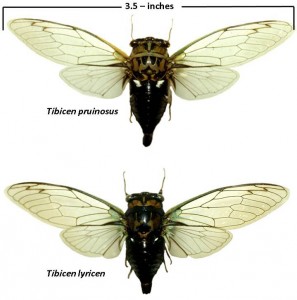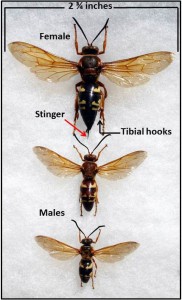–by Dr. Bob Bauernfeind
Yesterday morning (July 7) as I walked out the back door of Waters Hall, two men were servicing a couple of AC units. They were being intimidated by BIG WASPS. I asked them if they were worried to which one responded, “Look at the size of them things. I don’t want to get stung!”
Aha! The proverbial “teachable moment”. I went back to my office and got an insect net. Back outside, I netted a wasp and reached into the net and grabbed the wasp. The workers gave me a quizzical look, like, “What are you? Nuts?” But I explained to them that this was a male cicada killer wasp — and that male wasps (of any species) do not possess a stinger. I then had each of them grasp the wasp and then take a close look at it. “See? No stinger”. They were relieved to know that they could work carefree and would not be on the receiving end of a painful sting.
So, yes cicada killer wasp activities are in full swing. Already long-gone are the periodical cicadas (well, “long” depends upon how one defines long). So how will cicada killer wasps survive? They will rely upon their yearly supply of “annual cicadas”.
Currently, two early-summer species are singing away. I heard my first Tibicen pruinosus the evening of June 24, and first T. lyricen mid-day on July 2.
In comparison to the recent periodical cicadas, both of T. pruinosus and lyricen are larger and thicker-bodied with impressive wingspreads.
Both T. pruinosus and T. lyricen are tree-inhabiting species. But side-by-side, they are visually inseparable based upon their individual distinct body patterns and coloration. By far, T. pruinosus surpasses T. lyricen in terms of population levels, their wider distribution in Kansas, and their longer period-of-activity which extends well into Fall (T. lycerin’s “run” is completed by mid-August). The familiar ZzuhWhee ZzuhWhee ZzuhWhee ZzuhWhee (typically beginning in the late afternoon into the evening) is the most familiar sound heard coming from high-in-trees in cities and towns throughout Kansas.
But back to cicada killer wasps. Digging back in the vault-of-time and dusting off and somewhat modifying a previously used Kansas Insect Newsletter article —- good then and good now:
There are many types and species of wasps. Vespid wasps (including the familiar paper wasps, yellow jackets and baldfaced hornets) live in “colonies” consisting of a single egg-laying queen and her attendant female workers who will defensively protect the colony against intruders/people who (even if) accidentally disturb the nest/nesting site. In contrast, sphecid wasps (most familiar and recognized are mud daubers which build “mud nests”) are solitary species with just a single female tending her nest. Sphecid wasps are docile and unlikely to sting unless provoked by being carelessly handled or accidentally stepped on.
Thus, cicada killer wasps (despite their appearance and large size) are nothing to be feared. The female uses her stinger to paralyze a cicada. The cicada remains a “juicy” (as opposed to becoming dried out) food source for the wasp larva.
Male cicada killer wasps do not possess a stinger (as already mentioned above). Never-the-less, they appear menacing due to their erratic swarming as they establish territories and seek female mates. While occasionally one might accidentally bump into a person, it is not “attacking”.
Once a male has established his own small territory, he will be on active patrol protecting against interlopers. Buzzing about, he may hover and circle a person. While this may be intimidating, again, he cannot sting!
Cicada killer wasps have a 1-year life cycle. Whereas males do little more than mate, you have to admire female cicada killer wasps —– they do all the work. She selects a preferred site (often a bare sandy area) in which to construct her burrow. Nests are 8 to 20-inches underground. Using her mandibles and legs, she digs/loosens/”kicks out” soil particles which results in the creation of a dirt mound at the burrow entrance. There is a central tunnel off of which are separate side cells/chambers.
After the structural completion of the nest, she begins the provisioning process. Each chamber contains a single-to-several paralyzed cicadas. After depositing a single egg, the cell is sealed off with dirt. Within the cell, a newly-emerged larva feeds and matures. By mid-summer, it forms a cocoon inside of which it spends the remainder of the summer, the fall and winter. In the late spring, the larva pupates. “New” cicada killer wasps emerge in early summer, mate, and repeat the cycle.
It is not coincidental that nesting areas tend to be close to wooded areas. Given that many cicada species are arboreal, trees are ideal sites for locating cicada hosts. Another advantage of trees? They provide a high point. That is, because a cicada far outweighs the female cicada killer wasp, she is already high enough that she can spread her wings and be airborne. Should she fall short of reaching her nest, and because she cannot take off from the ground with her heavy “cargo”, she will drag her cicada up another tree (or some other convenient high point) to again become airborne. The last part of her journey may be on foot when she is close enough to the nest entrance. She then drags her captured cicada to the entrance of, and into the burrow. This process is repeated time after time after time after time until all of the chambers are provisioned, eggs deposited, chambers sealed and the burrow entrance closed.
A point of interest: females use their middle pair of legs to wrap around/hold the paralyzed cicada. Furthermore, the tibia of the female’s hind legs possesses a pair of hook-like appendages (see image above) used to hold/maintain the cicada parallel to its body when in flight. In an experiment where those appendages were removed, the middle legs still secured the cicada although it dangled beneath the wasp as she flew.
Comes the question, “How do I get rid of the cicada killer wasps around my house? I’m worried about being stung!” If you have read through to this point in this article, you already know that you need not be overly concerned about, “….. being stung!” But still, if there is the desire/need to do something, the best procedure would be to observe and identify where the nest openings are. Wait until the female departs. Between that time and when she returns, apply an insecticide into the entryway. (There currently are 795 different products registered for use in Kansas against wasps. Shop-the-shelves at local retail outlets for product availability in your area.) When the female wasp returns, contact with the insecticide will probably lead to her eventual demise. Whether the insecticide will kill the developing larvae is questionable as they are protected by the dirt wall closing off its underground incubation chamber.
The practicality of the above? One or two mounds/nests? Doable. Many mounds/nests? Probably impractical. It is up to an individual’s best judgment as to what to do. But maybe consider altering “the attractiveness” for next-year’s bout. Renovate lawn areas —- restore a thick vigorous turf which would have females searching elsewhere for a thin/bare area in which to raise her brood. Also, maintain a moist soil as that would tend to deter her from wanting to expend maximum excavation efforts. In flower bed areas, a layer of gravel or mulch may dissuade her from setting-up-house.
From the viewpoint of an entomologist: take the opportunity to watch and be fascinated by these harmless creatures. If adventurous, put your hand next to her burrow entrance. When “Madam” exits, she may crawl onto your hand. You’ll find yourself talking to her. She may move her head this way or that as if to say, “Nice chatting with you. But I must be off. I have more work to do.”

